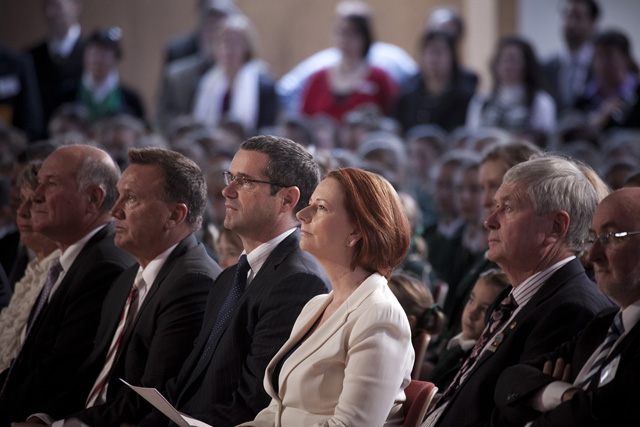Communications Minister Stephen Conroy this morning released the Federal Government’s Digital Economy Strategy, a document which aims to lay out a vision for how the nation will best take advantage of the Government’s flagship National Broadband Network project.
The document – which is available in full online – lays out eight key areas which the Government hopes to develop as the NBN is rolled out over the next eight years, to position Australia as a global technology powerhouse. Conroy announced the release of the strategy as part of the CeBIT trade show and conference series kicked off in Sydney this morning.
The areas the Government wants to focus on are participation in the Internet by households, businesses and non-profit organisations, smart management of the environment and infrastructure, improved health and aged care, expanded online education, increased teleworking, improved online government service delivery and engagement, and greater digital engagement in regional Australia.
By implementing the strategy, Conroy promised this morning, Australia would become “a leading digital economy” by the year 2020, when the NBN construction is slated to be finished. Australia has not typically been seen as strong when it comes to creation of new technology, with international markets more associating countries such as the US, Germany and Japan with such strengths — and Australia with mining, farming and tourism.
However, Conroy said this morning all that was slated to change.
He noted the Government had set a series of eight corresponding goals to be met by the 2020 target date, including achieving a top five spot on the Organisation for Economic Development’s tables listing the proportion of each countries’ residents connected to broadband; 90 percent of high-priority consumers such as older Australians, mothers and babies having access to an electronic health record; four out of five Australians choosing to interact with the Government online, and so on.
“By connecting to high-speed broadband, households will benefit through savings generated from time-saving activities such as telecommuting for remote work and study and improved access to business and job opportunities, health, education, social and government services,” Conroy said.
The Government has also this morning outlined a series of funding packages that will assist in it meeting its goals over the next decade.
For starters, Conroy said the Government would provide $23.4 million over three years towards what he described as a “Digital Communities” initiative, which would see ‘Digital Hubs’ established in each of the 40 communities to first receive the NBN. An additional $12.4 million over three years will be provided to assist small to medium business and not-for-profit enterprises in and around those 40 sites to help them fully utilise the NBN.
$21.7 million over four years will go towards a program designed to support the development of online and interactive education and training projects, while a $5.5 million package will look at helping people in regional areas access “quality healthcare” through telehealth and health outreach services.
As part of that funding, the Princess Alexandra hospital in Queensland is to receive $2.01 million towards establishing “a landmark suite of telehealth services” to support Queenslanders, while $3.5 million will go towards a trial of in-home health services for Townsville residents with diabetes.
The Digital Economy strategy was immediately welcomed by at least one industry group, with the Australian Information Industry Association praising the Government’s change in narrative around the NBN.
“We need to shift from network and technical discussions to participation and content,” said AIIA CEO Ian Birks in a statement. “That is the only reason to roll out broadband on a national scale, the only way that its value will be realised and the priority for Australia’s role in the global economy. This strategy represents the first step towards that shift.”
“The government’s eight-point plan … certainly reflects the focus that we need to make as a nation,” said Birks. “AIIA has long argued for a measured approach, and we are particularly pleased to see the introduction of key metrics in each of these areas that aim to track and meet specific economic and community goals by 2020.”
“Broadband infrastructure is an essential foundation for Australia, but it is only a means to an end,” Mr Birks said. “The end-game for Australia will be the establishment of a vibrant digital economy that maximises the ability of business and industry to compete both domestically and internationally.”
Image credit: NBN Co

